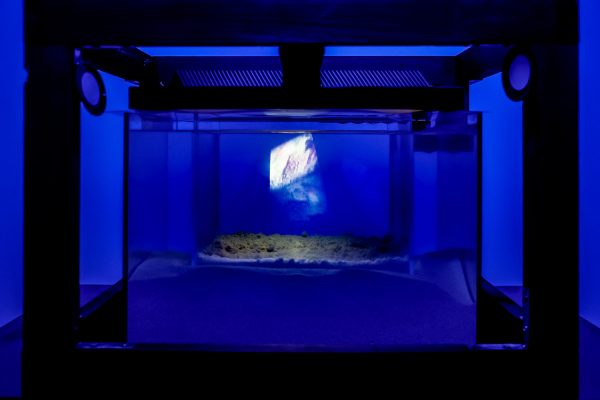張國樑 Weera It ITTITEERARAK
張國樑 (วีระอิทธิ์ อิทธิธีรรักษ์; Weera-it Ittiteerarak) ,生於1994年,香港跨媒體藝術家。作為出生於香港的泰國人,具有豐富的跨文化背景,能夠發展獨特的敏感性,從而在藝術和科學上通過周圍的環境進行研究。研究涉及人類和非人類的關係、精神病學和可持續性。他專注於與人類福祉相關的主題,並通過各種媒介創造人為的自然。
對藝術和科學有著濃厚的興趣,傳統媒介並沒有限制實踐方法。在2015年被診斷出患有PDD-NOS(未另作說明的普遍性發育障礙);通過聲音,光線和氣味觸發人類的感覺,從而改變了在藝術實踐中的感官敏感性。裝置作品獲得了大學和政府的認可。
正在進行的研究項目 Scriffice:Dabble(2019-)和 Symbiosis with Weeds (2020-) 調查了海洋中和陞地上的人類活動踪跡。該項目挑戰了人工技術如何侵入自然環境的觀點;與向大家發問人與自然的關係。不可容忍的元素和對象(水和電子設備)反映了資本主義與自然之間的差異;及後人類主義用作解放和拆解人與非人類的關係。通過使用數據收集,i尋求找到內在的和平並激發我們對社會內部自然環境的理解。
他於2020年獲得香港城市大學創意媒體學院的新媒體文理學學士學位(榮譽)。
Weera-it Ittiteerarak (วีระอิทธิ์ อิทธิธีรรักษ์; 張國樑) is also known as itit (b. 1994) is a Hong Kong-based interdisciplinary artist. As Hong Kong-born-Thai, itit has a rich cross-cultural background that allows him to develop unique sensitives that nurture through his surroundings artistically and scientifically.
itit interests span in environmental, psychiatric and sustainability of the human and non-human relationships. He focuses on the effectiveness of light that relates to human well-being and creating artificial and natural creation through various mediums.
itit has a huge interest in art and science, the traditional medium does not bound his practice. He diagnosed as in PDD-NOS (Pervasive Developmental Disorder Not Otherwise Specified) in 2015; he transforms his sensitivities of senses in his artistic practice by triggering the human sensations through sound, light, and smell. His installation artworks gain recognition from the university and local government.
The ongoing research project, Scriffice: Dabble (2019- ) and Symbiosis with Weeds (2020-) investigates the trace of human activities in the ocean and land. Aims to use technology to create an analog in the Hong Kong ocean by looking into the ocean waste. And reconnect the relationship between humans and the environment. The project challenges the perspective on how artificial technology invades the natural environment and questioning the meaning of humans in the 21st century. The intolerable element and object (water and electronic device) reflect on the difference between capitalism and nature; while the post-humanism to revealing and deconstruct the interconnection of human and nonhuman. Using data collection, itit seeks to find inner peace and provoke our understanding of the natural environment within our society.
He received his BAS (honors), New Media from the School of Creative Media at the City University of Hong Kong in 2020
浪漫現實主義
我在居家工作室工作,所以我的實踐跟生活環境與研究息息相關。我試圖探索人與非人之間的關係。我每天都會至少兩次定時遛狗。她引導我觀察,因為她對週圍的元素,例如噪音、氣味、動作都很敏感,也讓我對週圍的環境很敏感。在慢步的過程中,環境的變化是如此的明顯,這種習慣成了我做藝術的靈感繆斯。我不想說自己在 「創造」藝術,也不想說自己在「創作」,反而那一種「生命力」對藝術活動產生幫助。而且比起做一個 「項目」,更多的是日常的「實踐」,是一種習慣的延續,讓我對非人的事物產生敏感和靈感。
我命名我的方法論為「浪漫現實主義」,此相對於「檔案浪漫」和「改造現實」。浪漫主義和寫實似乎是兩個對立面,把存在的物質世界或事實浪漫化,把抽象的意義真實化是需要練習的。
我覺得現在香港的情況確實令很多人都很沮喪。如果說(有某些情況)我不能創作,我反而會說我不能發展跟生活或生命無關的藝術作品。我需要藥物來平息我的情緒。情緒佔據了我從事各種活動的能力,我一直在努力把自己和香港聯繫起來,這是一種生存的適應。
Romantic-realism
I work in my home studio, so my practice relates to my living environment and also to my research. I’m trying to explore the relationship between human and nonhuman. Everyday, I walk my dog at least twice regularly. She guides me to observe, as she stays really alert to the surrounding elements, such as noise, smell, and movement; she also makes me sensitive to the surroundings. In a slow walking journey, the environment’s changes are so noticeable, this kind of habit became my muse for doing art. I do not want to say I’m ‘creating’ art or ‘creativity’, but it is a ‘vitality’ in addition to the art activity. And it is more about the daily ‘practice’ than working on a ‘project’, a continuity of habits that leads me to be sensitive and inspired by the nonhuman.
I entitle my methodology as Romantic-realism, as to archival romance and transform reality. While romanticism and realism seem on the opposite sides of the spectrum, it is the practice to romanticise the physical world or fact; and to realisticize the abstractional meanings.
I think the situation in Hong Kong really makes a lot of us down. If there is a situation that I cannot create artwork, I would rather say I cannot develop artworks unrelated to life or living. I need medicines to calm me down. The emotions occupy my ability to do all kinds of activities, which I have been trying to connect myself with Hong Kong, an adaptation to survive.
- 黃康迪 WONG Hong Tik
- 陳毅哲 CHEN Yi Che
- 馮以丹 Edy FUNG
- 李劻華 Khris LEE Hong Wah
- 詹昫嵐 Liv TSIM
- 梁慧欣 LEUNG Wai Yan
- 梅愷盈 MUI Hoi Ying, Carol
- 黎穎虹 LAI Wing Hung
- 張綺君 CHEUNG Yee Kwan, Sonia
- 強天锴 QIANG Tiankai
- 朱建林 ZHU Jianlin
- 鄺詠君 KWONG Wing Kwan
- Iris WONG
- 楊思嘉 Sijia YANG
- 張文智 ZHANG Wenzhi
- 盧韻淇 LO Wan Ki
- 馮靖嵐 FUNG Ching Laam
- 張亦勤 CHEUNG Yick Kan
- 葉雯 Manny YIP
- 無碼計劃 Project NoCode
- 劉菁兒 LAU Ching Yee, Cathleen
- 余榮基 YU Wing Kei, Rik
- 劉暢 LIU Chang
- 陳翠雯 CHAN Chui Man
- 許芷瑋 HUI Gi-Wai, Echo
- 譚綽琳 TAM Cheuk Lam, Jessie
- 鄭天依 ZHENG Tianyi
- 王昱珊 WONG Yuk Shan
- 李曉巧 LI Xiaoqiao
- 屈鍵晴 WAT Kin Ching
- 劉清華 LAU Ching Wa, Jess
- 曾淑芬 TSANG Shuk Fan, Tracy
- 張紫茵 Dorothy CHEUNG
- 林琬晴 LAM Yuen Ching, Esther
- 彭景 PENG Jing
- 馮以力 FUNG Yee Lick, Eric
- 張家樺 Janice CHEUNG
- 鄧廣燊及袁雅芝 TANG Kwong San & YUEN Nga Chi
- 潘美義 POON Mei Yee
- 徐然 XU Ran
- Florence LAM
- 朱穎琳 CHU Wing Lam, Kelly
- 黃姬雪 WONG Kei Suet, Ice
- 余淑培 YU Shuk Pui, Bobby
- 鄧卓敏 TANG Cheuk Man, Penelope
- 李珮瀅 LEE Pui Ying, Hiya
- 吳咏詩 Wing Sze NG
- 張國樑 Weera It ITTITEERARAK
- 黃詩慧 WONG Sze Wai
- 鄭裕林 CHANG Yue Lam
- Landescape1823
- 鄭虹 CHENG Hung, Dony
- 陳庭 CHAN Ting
- 馮倚天 FUNG Yee Tin, Thomas
- 譚敏晴 TAM Man Ching, Michelle
- 朱湘 ZHU Xiang
- 程新皓 CHENG Xinhao
- 沈軍 SHEN Jun
- 梁望琛 LEUNG Mong Sum, Joseph
- 李繼忠 LEE Kai Chung

